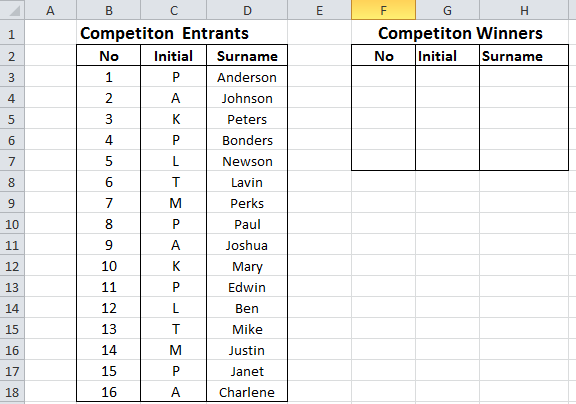

Real Statistics Excel Functions: The Real Statistics Resource Pack provides the following useful array functions that allow you to avoid the complex syntax described above. Observation: If we wanted to generate a sample of size 6 with replacement, we would use the following formula in cell C4 instead (column B would not be necessary): See Built-in Excel Functions and Table Lookup for more information about the INDEX function. This will place the formula =RAND() in every cell in the range B4:B23.įinally create column C by putting the following formula in cell C4 and then copying it down (using Ctrl-D as described above) for as many rows as you want items in the sample. Simply enter =RAND() in cell B4 and then highlight the range B4:B23 and enter Ctrl-D. These are generated using the Excel function RAND(). Column B consists of random numbers between 0 and 1. We accomplish this by creating a worksheet as in Figure 2.įigure 2 – Creating a random sample without replacementĬolumn A consists of the data elements in the population (as taken from Figure 1).

We now show how to create the Group 1 sample above without duplicates.Įxample 2: Recreate Group 1 from Example 1 without allowing any duplicates. As you can see from the example, the number 2 is chosen twice in the Group 1 sample.Īs a result, it often better to use other approaches to create a sample.
The Label option does not function properly and so should not be used. If in the example above the number of women is not equal to the number of men any blank cells will simply be treated as data and can be chosen for inclusion in a sample. Only numeric data (including blank) can be used. Observation: The Sampling data analysis tool has a number of limitations which unfortunately reduces its usefulness. For Group 2 you select the 10 cells in the Women column as Input Range and Periodic with Period 3. For Group 1 you select all 20 population cells as the Input Range and Random as the Sampling Method with 6 for the Random Number of Samples. You need to run the sampling data analysis tool twice, once to create Group 1 and again to create Group 2. sampling is with replacement).Įxample 1: From a population of 10 women and 10 men as given in the table in Figure 1 on the left below, create a random sample of 6 people for Group 1 and a periodic sample consisting of every 3 rd woman for Group 2.įigure 1 – Creating random and periodic samples This number of values is drawn from random positions in the input range. Random – In this case, you specify the Random Number of Samples. Sampling stops when the end of the input range is reached. The nth value in the input range and every nth value thereafter is copied to the output column. Periodic – In this case, you specify the Period n at which you want sampling to take place. Sampling Method – Select one of the following two sampling intervals: Excel draws samples from the first column, then the second column, and so on. Input Range – Specify the range of data that contains the population of values you want to sample. The tool works by defining the population as an array in an Excel worksheet and then using the following input parameters to determine how you would like to carry out the sampling. Excel provides a Sampling data analysis tool that can be used to create samples.






 0 kommentar(er)
0 kommentar(er)
